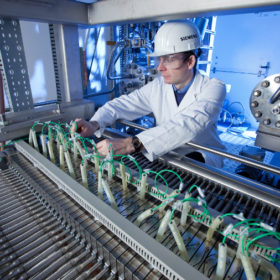
Scientists at the University of Houston in the United States have developed a new catalyst which they say can efficiently produce hydrogen from seawater. The group says that its discovery significantly advances the development of seawater electrolysis for large-scale hydrogen production.
A research group at the University of Houston has designed a new type of catalyst, which was demonstrated to reduce the voltage required to power water electrolysis, potentially solving many of the problems with producing hydrogen direct from seawater.
Water splitting with fresh water has been demonstrated at high efficiencies, and commercial applications already exist for the technology, which will likely play an important role in the transition to a cleaner energy system.
For seawater, which represents around 96% of the world’s total water resources, controlling the reaction is more challenging. Catalysts that can split hydrogen from water also tend to free other particles of sodium, chlorine and other elements commonly found in seawater, and these can settle on the catalyst, damaging its performance and causing electrodes to simply fall apart.
A previous paper published by Stanford University found that a negatively charged layer in the anode could effectively protect its core materials against chlorides found in seawater. The group at Houston, however, decided on a different approach and sought a catalyst that could achieve high current density at a low voltage.
Luo Yu, postdoctoral researcher at University of Houston, notes that the voltage is important because hydrogen can be produced at 1.23 V, while chlorine requires a voltage of at least 1.73 V. So a device that produces industrially required density at a voltage between these two is highly desirable.
The oxygen evolution reaction catalyst designed by the group, described in Nature Communications, relies on transition metal-nitride, with nanoparticles made of a nickel-iron-nitride compound and nickel-molybdenum-nitride nanorods on porous nickel foam.
This catalyst was integrated into a two electrode electrolyzer. Combined with a hydrogen evolution catalyst consisting of nickel-molybdenum nanorods, the device achieved current densities of 500 mA at 1.608 V, and 1000 mA at 1.707 V in natural seawater at a temperature of 60 degrees Celsius, which the group claims is a record low.
“This discovery represents a significant step in the development of a robust and active catalyst to utilize the world’s abundant seawater feedstock for large-scale hydrogen production by renewable energy sources,” the researchers claim in Nature Communications.
Lắp đặt điện mặt trời Khải Minh Tech
https://ift.tt/2X7bF6x
0906633505
info.khaiminhtech@gmail.com
80/39 Trần Quang Diệu, Phường 14, Quận 3
Lắp đặt điện mặt trời Khải Minh Tech
https://ift.tt/2ZH4TRU
Không có nhận xét nào:
Đăng nhận xét